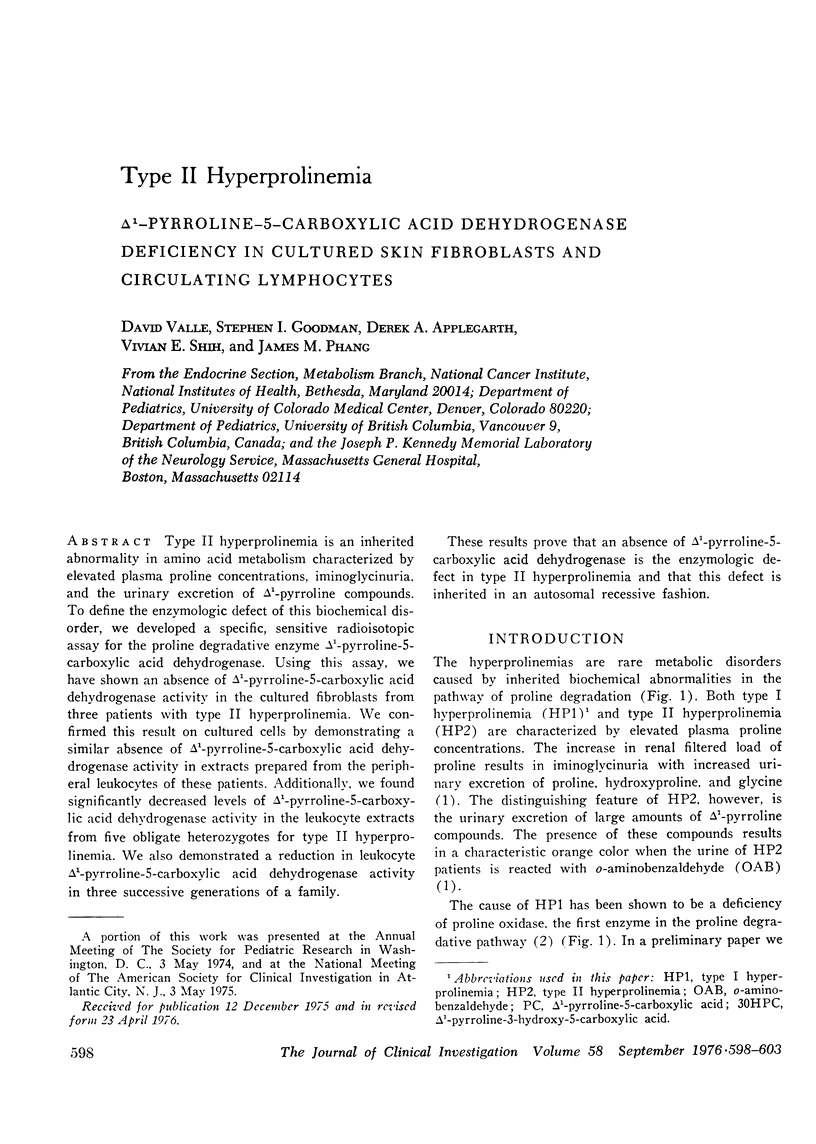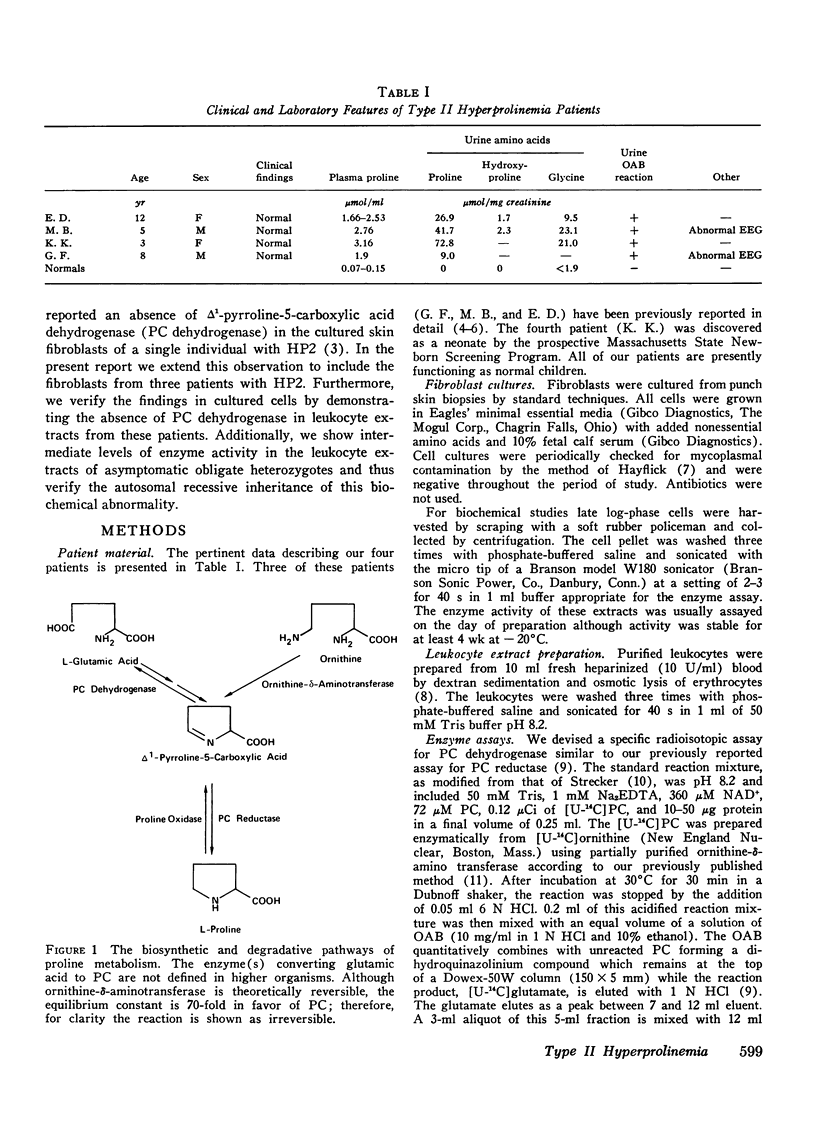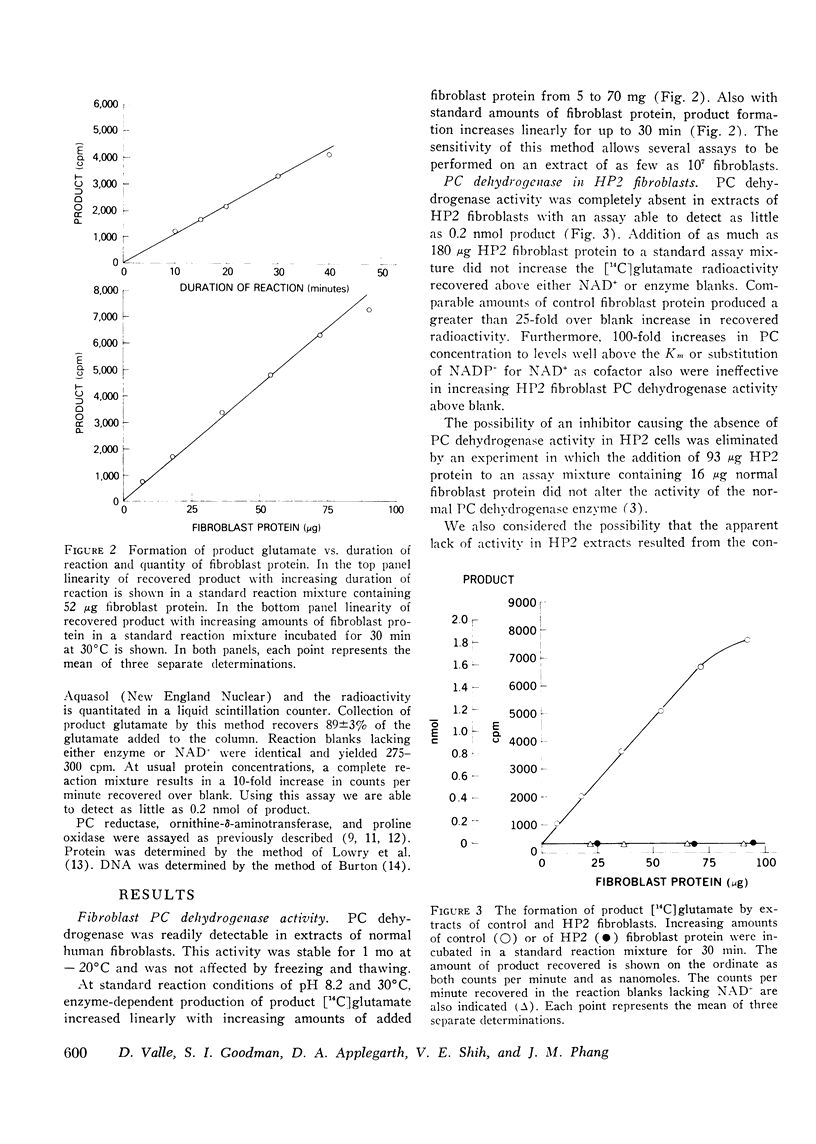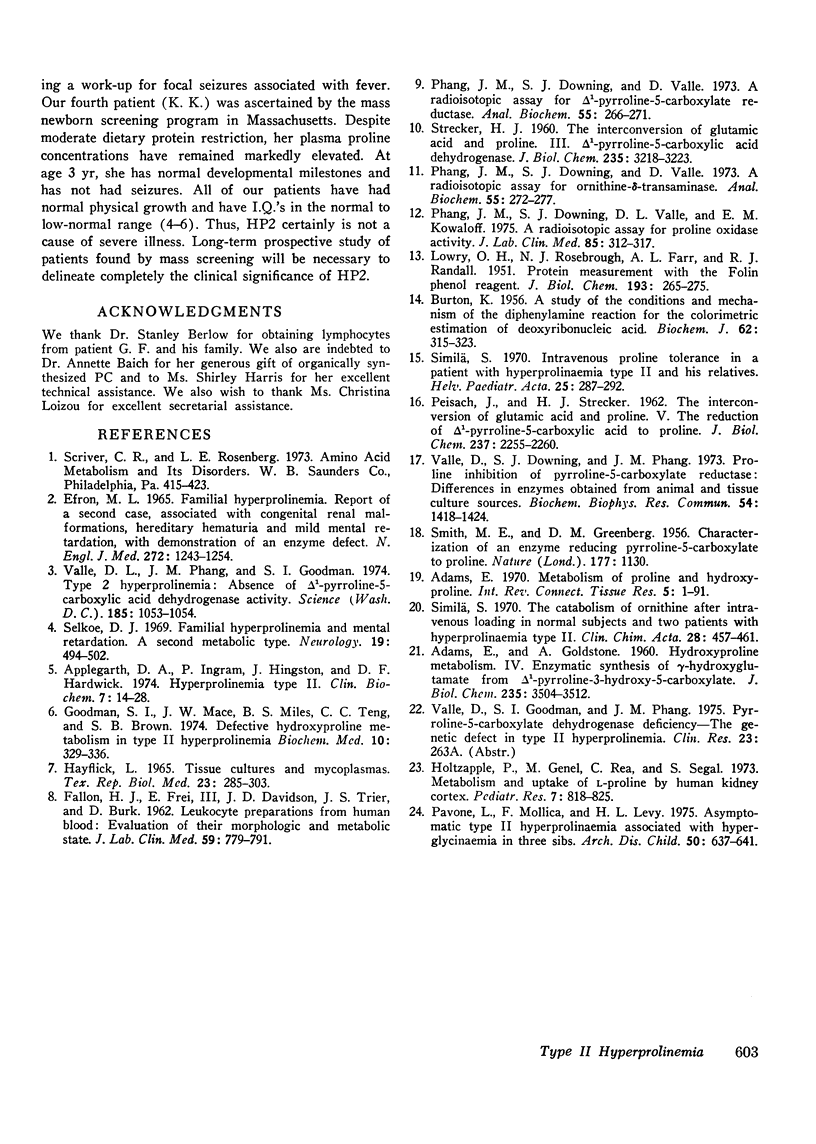Abstract
Type II hyperprolinemia is an inherited abnormality in amino acid metabolism characterized by elevated plasma proline concentrations, iminoglycinuria, and the urinary excretion of delta1-pyrroline compounds. To define the enzymologic defect of this biochemical disorder, we developed a specific, sensitive radioisotopic assay for the proline degradative enzyme delta1-pyrroline-5-carboxylic acid dehydrogenase. Using this assay, we have shown an absence of delta1-pyrroline-5-carboxylic acid dehydrogenase activity in the cultured fibroblasts from three patients with type II hyperprolinemia. We confirmed this result on cultured cells by demonstrating a similar absence of delta1-pyrroline-5-carboxylic acid dehydrogenase activity in extracts prepared from the peripheral leukocytes of these patients. Additionally, we found significantly decreased levels of delta1-pyrroline-5-carboxylic acid dehydrogenase activity in the leukocyte extracts from five obligate heterozygotes for type II hyperprolinemia. We also demonstrated a reduction in leukocyte delta1-pyrroline-5-carboxylic acid dehydrogenase activity in three successive generations of a family. These results prove that an absence of delta1-pyrroline-5-carboxylic acid dehydrogenase is the enzymologic defect in type II hyperprolinemia and that this defect is inherited in an autosomal recessive fashion.
Full text
PDF





Selected References
These references are in PubMed. This may not be the complete list of references from this article.
- ADAMS E., GOLDSTONE A. Hydroxyproline metabolism. IV. Enzymatic synthesis of gamma-hydroxyglutamate from Delta 1-pyrroline-3-hydroxy-5-carboxylate. J Biol Chem. 1960 Dec;235:3504–3512. [PubMed] [Google Scholar]
- Adams E. Metabolism of proline and of hydroxyproline. Int Rev Connect Tissue Res. 1970;5:1–91. doi: 10.1016/b978-0-12-363705-5.50007-5. [DOI] [PubMed] [Google Scholar]
- Applegarth D. A., Ingram P., Hingston J., Hardwick D. F. Hyperprolinemia type II. Clin Biochem. 1974 Mar;7(1):14–28. doi: 10.1016/s0009-9120(74)90174-x. [DOI] [PubMed] [Google Scholar]
- BURTON K. A study of the conditions and mechanism of the diphenylamine reaction for the colorimetric estimation of deoxyribonucleic acid. Biochem J. 1956 Feb;62(2):315–323. doi: 10.1042/bj0620315. [DOI] [PMC free article] [PubMed] [Google Scholar]
- EFRON M. L. FAMILIAL HYPERPROLINEMIA. REPORT OF A SECOND CASE, ASSOCIATED WITH CONGENITAL RENAL MALFORMATIONS, HEREDITARY HEMATURIA AND MILD MENTAL RETARDATION, WITH DEMONSTRATION OF AN ENZYME DEFECT. N Engl J Med. 1965 Jun 17;272:1243–1254. doi: 10.1056/NEJM196506172722401. [DOI] [PubMed] [Google Scholar]
- FALLON H. J., FREI E., 3rd, DAVIDSON J. D., TRIER J. S., BURK D. Leukocyte preparations from human blood: evaluation of their morphologic and metabolic state. J Lab Clin Med. 1962 May;59:779–791. [PubMed] [Google Scholar]
- Goodman S. I., Mace J. W., Miles B. S., Teng C. C., Brown S. B. Defective hydroxyproline metabolism in type II hyperprolinemia. Biochem Med. 1974 Aug;10(4):329–336. doi: 10.1016/0006-2944(74)90036-2. [DOI] [PubMed] [Google Scholar]
- Hayflick L. Tissue cultures and mycoplasmas. Tex Rep Biol Med. 1965 Jun;23(Suppl):285+–285+. [PubMed] [Google Scholar]
- Holtzapple P., Genel M., Rea C., Segal S. Metabolism and uptake of l-proline by human kidney cortex. Pediatr Res. 1973 Oct;7(10):818–825. doi: 10.1203/00006450-197310000-00005. [DOI] [PubMed] [Google Scholar]
- LOWRY O. H., ROSEBROUGH N. J., FARR A. L., RANDALL R. J. Protein measurement with the Folin phenol reagent. J Biol Chem. 1951 Nov;193(1):265–275. [PubMed] [Google Scholar]
- PEISACH J., STRECKER H. J. The interconversion of glutamic acid and proline. V. The reduction of delta 1-pyrroline-5-carboxylic acid to proline. J Biol Chem. 1962 Jul;237:2255–2260. [PubMed] [Google Scholar]
- Pavone L., Mollica F., Levy H. L. Asymptomatic type II hyperprolinaemia associated with hyperglycinaemia in three sibs. Arch Dis Child. 1975 Aug;50(8):637–641. doi: 10.1136/adc.50.8.637. [DOI] [PMC free article] [PubMed] [Google Scholar]
- Phang J. M., Downing S. J., Valle D. L., Kowaloff E. M. A radioisotopic assay for proline oxidase activity. J Lab Clin Med. 1975 Feb;85(2):312–317. [PubMed] [Google Scholar]
- Phang J. M., Downing S. J., Valle D. A radioisotopic assay for delta1-pyrroline-5-carboxylate reductase. Anal Biochem. 1973 Sep;55(1):266–271. doi: 10.1016/0003-2697(73)90312-6. [DOI] [PubMed] [Google Scholar]
- Phang J. M., Downing S. J., Valle D. A radioisotopic assay for ornithine-delta-transaminase. Anal Biochem. 1973 Sep;55(1):272–277. doi: 10.1016/0003-2697(73)90313-8. [DOI] [PubMed] [Google Scholar]
- SMITH M. E., GREENBERG D. M. Characterization of an enzyme reducing pyrroline-5-carboxylate to proline. Nature. 1956 Jun 16;177(4520):1130–1130. doi: 10.1038/1771130a0. [DOI] [PubMed] [Google Scholar]
- Selkoe D. J. Familial hyperprolinemia and mental retardation. A second metabolic type. Neurology. 1969 May;19(5):494–502. doi: 10.1212/wnl.19.5.494. [DOI] [PubMed] [Google Scholar]
- Simila S. The catabolism of ornithine after intravenous loading in normal subjects and two patients with hyperprolinaemia type II. Clin Chim Acta. 1970 Jun;28(3):457–461. doi: 10.1016/0009-8981(70)90073-2. [DOI] [PubMed] [Google Scholar]
- Similä S. Intravenous proline tolerance in a patient with hyperprolinaemia type II and his relatives. Helv Paediatr Acta. 1970 Jul;25(3):287–292. [PubMed] [Google Scholar]
- Valle D. L., Phang J. M., Goodman S. I. Type 2 hyperprolinemia: absence of delta1-pyrroline-5-carboxylic acid dehydrogenase activity. Science. 1974 Sep 20;185(4156):1053–1054. doi: 10.1126/science.185.4156.1053. [DOI] [PubMed] [Google Scholar]
- Valle D., Downing S. J., Phang J. M. Proline inhibition of pyrroline-5-carboxylate reductase: differences in enzymes obtained from animal and tissue culture sources. Biochem Biophys Res Commun. 1973 Oct 15;54(4):1418–1424. doi: 10.1016/0006-291x(73)91144-3. [DOI] [PubMed] [Google Scholar]


